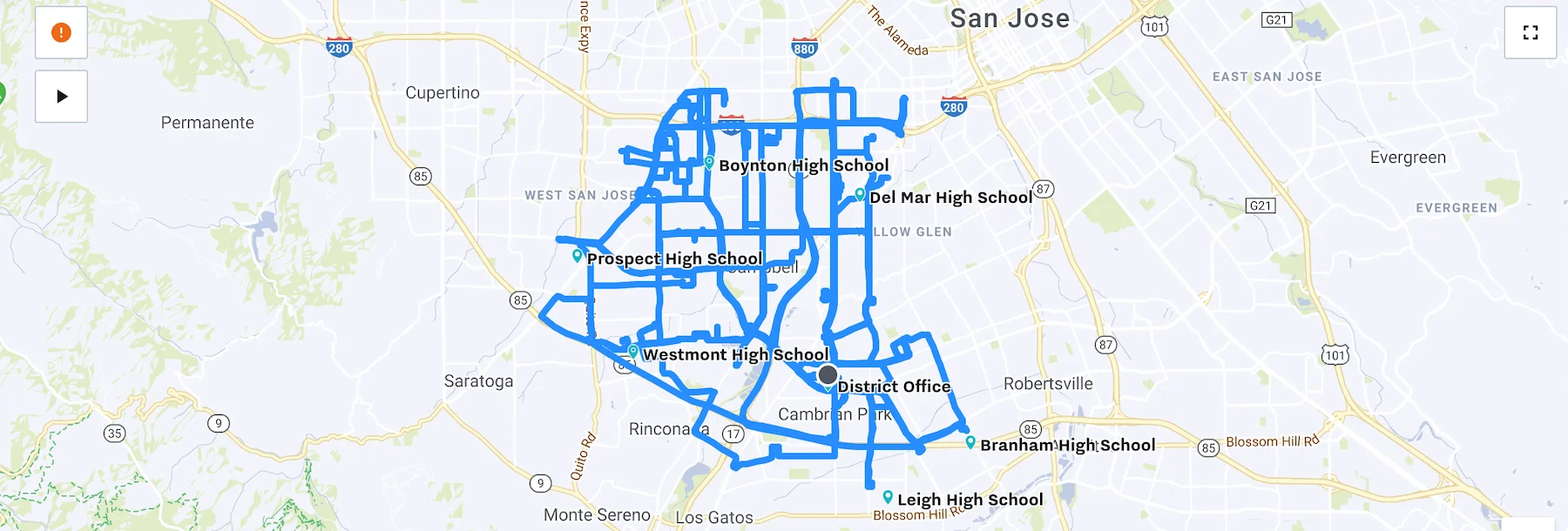Customer Stories, Fleet Management, Routing, Customer Tips, Efficiency
How Campbell Union High School District Keeps Students Connected with Samsara
June 16, 2020

Campbell Union High School District (CUHSD) serves more than 8,300 students at five campuses in San Jose, California. Before the COVID-19 pandemic, you could find any of their 13 school buses or 50 white fleet vehicles transporting students or district employees. But when shelter-in-place restrictions forced schools to close and students to continue learning from home, CUHSD faced a new challenge.
To accommodate students and families as they transitioned to online learning, the district needed a way to ensure that all students had proper access to technology, such as laptops and WiFi, so they could continue to learn from home.
Leading this transition was John Keating, CUHSD’s Director of Technology. After the Bay Area announced a shelter-in-place order in March, Keating and his team partnered with the district’s superintendent to find a way to use their fleet to deliver critical technology to students. Read on to learn how they did it.
How mobile technology enables remote learning for thousands of students
With this transition to remote learning, Keating and his team were concerned that not every student had access to the technology they needed to continue their education. In order to determine who had internet and computer access at home, Keating sent a survey to every student. Within days, they had responses from 80% of their students showing that over 10% did not have continuous access to computers or WiFi throughout the day.
“Our students need individual access to technology to maintain their education,” said Keating. “We didn’t want to lose any educational time. We realized this was not going to be a snow day, and that remote learning would be the new norm.”
Thankfully, the school had about 400 old Chromebook laptops that were slated to be recycled that they could distribute to students in need. Within hours of the shelter-in-place order, Keating and his team set up a sanitization and refurbishing station in the district parking lot so they could make sure each laptop was ready for use.
In the first week, Keating and his team used district vans to distribute the Chromebooks and WiFi hotspots to campuses throughout the district, where students could go and check out the equipment. But because students didn’t always have access to transportation (and many students’ parents are essential workers), this model didn’t accommodate all students.
That’s when Keating and his team knew they needed to find a way to deliver necessary devices directly to their students’ homes.
Deploying the district’s fleet to distribute essential technology
After two weeks, they moved to a delivery model—using their fleet to deliver laptops and hotspots to students’ homes across the city. “We were not going to allow any barriers to prevent our students from remote learning,” said Keating. Quickly, Keating and his team leveraged Samsara’s route optimization tools to maximize the efficiency of their deliveries by finding the most direct route. Before Samsara, Keating explained that they would have had to put the individual students’ addresses into MapQuest and manually draw the routes between addresses.
Keating simply uploaded students’ home addresses into Samsara and was able to minimize the time and distance in between stops. “It’s been helpful to have a system that tells us the most efficient route so that we can save time and avoid driving from one side of the city to the other,” said Keating.
In one instance, someone called into the district’s family hotline to request a hotspot, and Keating was able to quickly locate one of his technicians in the area and dispatch him to the student’s home in under 10 minutes.
“Having mobile technologies in place and being able to access every piece of information from our laptops was really important as we made the transition to remote learning,” said Keating. “Because we already had Samsara installed in our fleet, we were able to leverage route optimization so that we could maximize the impact and ensure every student had technology.”
Continuing to make an impact on students’ education
Thanks to the district’s quick thinking, Keating and his team were able to deliver and distribute more than 650 Chromebooks and 250 WiFi hotspots in the first eight weeks of the shelter-in-place order. Not only did this prevent students from falling behind, but it also showcased the technology department’s ability to adapt quickly in order to provide quality services for their students.
With the help of Samsara Activity Reports, Keating and his team were also able to visualize the impact they had with their deliveries. “This wasn’t something that we’ve ever done before, so it was helpful to have the data from Samsara to validate that we were successful in enabling our students to continue their education,” said Keating.




















